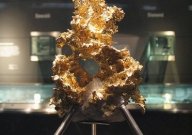Science & Technology
January 28, 2011 · 17 comments
17 comments

Image Credit: CC 2.0 Aram Dulyan
Source: Science Daily | Comments (17)
Scientists turn gold to purple
By T.K. RandallJanuary 28, 2011 ·
 17 comments
17 comments
Image Credit: CC 2.0 Aram Dulyan
A new way to harvest energy from sunlight has been found as gold turns purple in a new experiment.
Professor Richard Watt and his students have found a new way to harvest energy from sunlight by using a common protein. In their experiments, they mixed citric acid with the protein and added dissolved gold powder. After being exposed to sunlight for roughly 20 minutes, the solution turned purple, showing that the gold had been 'donated' electrons. The gold atoms used this energy to bunch together, forming purple colored nanoparticles.
This reaction signalled that the protein had used the sunlight to excite the molecules in the citric acid, creating a transfer of energy. The discovery could potentially be used as a new 'green' energy source.Professor Richard Watt and his chemistry students suspected that a common protein could potentially react with sunlight and harvest its energy -- similar to what chlorophyll does during photosynthesis.
Source: Science Daily | Comments (17)

The Unexplained Mysteries
Book of Weird News
AVAILABLE NOW
Take a walk on the weird side with this compilation of some of the weirdest stories ever to grace the pages of a newspaper.
Click here to learn more

Support us on Patreon
BONUS CONTENTFor less than the cost of a cup of coffee, you can gain access to a wide range of exclusive perks including our popular 'Lost Ghost Stories' series.
Click here to learn more
Israel, Palestine and the Middle-East
UK and Europe
United States and the Americas
Ancient Mysteries and Alternative History
Total Posts: 7,768,499 Topics: 325,026 Members: 203,771
Not a member yet ? Click here to join - registration is free and only takes a moment!
Not a member yet ? Click here to join - registration is free and only takes a moment!



























Please Login or Register to post a comment.